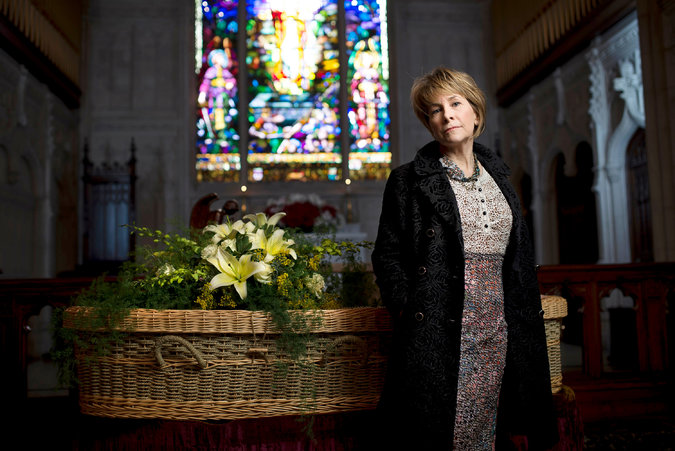Baby Boomers Are Drawn to Green and Eco-Friendly Funerals
Article By: Susan Chumsky, NY Times
First there was Slow Food. Now come slow funerals. On a recent frigid Sunday at the Park Slope Food Coop, Amy Cunningham was giving a PowerPoint talk on green funerals to a graying crowd of about two dozen, many of them note-takers. “I think when the baby boom is of age and we’re actively leaving this world, the environmentally friendly approach will be business as usual,” she said. “It will not be the odd thing.”
As New York City’s boomers shift from wooden toys to wooden boxes, Ms. Cunningham is hoping to ease their transition. A former writer for women’s magazines who now works for Greenwood Heights Funeral & Cremation Services, in Brooklyn, she pointed to a chart projected behind her showing that almost 50 percent more Americans would die in 2050 than in 2020. “I remember my parents saying, ‘Oh, God, it’s awful when your friends begin to die,’ ” said Ms. Cunningham, who is 58. “But we’re going to be seeing that and then more so because of the sheer demographics. I have to keep up with my yoga, because I hope to be able to help people through this period.”

Unlike the pricey organic produce at Whole Foods, back-to-basics funerals are usually cheaper than conventional ones. Ms. Cunningham said that a cremation in Brooklyn could cost less than $2,000, and her blog, The Inspired Funeral, lists 14 green cemeteries outside the city that charge less than those within it. The Green Burial Council estimates that one-quarter of older Americans want a green burial, and Ms. Cunningham said that about the same proportion of her clients make that choice.
Beyond the East River, too, the funeral industry is responding to a widespread desire for greener and more meaningful send-offs. In Sebastopol, Calif., Jerrigrace Lyons advocates home funerals and encourages families to spend more time with the body. Nature’s Casket, outside Boulder, Colo., makes rustic, handmade pine coffins that can be used premortem as bookshelves. Eternal Reefs, near Atlanta, helps clients turn cremated remains into personalized, eco-friendly “reef balls,” which are placed on the ocean floor, aiding the growth of coral reefs.
Even conventional funeral directors are bracing for changes in the American way of death. At the 2013 gathering of the mainstream National Funeral Directors Association last October, the workshops included “It’s Only a Matter of Time: Are You Ready for Natural Burials and Green Funerals?”
In the ’80s and ’90s, when Ms. Cunningham was writing for magazines like Glamour (as well as the late Mademoiselle, McCall’s and Lear’s), she could never have imagined that her future would involve embalming bodies at Bellevue or carrying a business card that read “Amy Cunningham, Funeral Director.” “I like to say that I’ve gone from working in an industry that fears death,” she said, “to one that embraces it.”
When Ms. Cunningham’s father died in Orangeburg, S.C., five years ago, she and her two siblings arranged what she called “the most glorious memorial service,” culminating with a jubilant farewell from a jazz band. “I came back to Brooklyn,” she said, “obviously quite miserable that my 94-year-old father was dead but elated at what we had built as a family.” When she suggested to her husband that she might want to turn this experience into her next vocation, he didn’t laugh.
In 2010, she began taking classes in embalming, restorative arts, anatomy and chemistry at the American Academy McAllister Institute of Funeral Service, on the far West Side of Manhattan, with classmates half her age. After a year, Erin T. Gigoux, Greenwood’s owner, hired her for a one-year residency at another funeral home he owned, and soon she was transporting bodies on stretchers and driving a hearse, careful never to listen to NPR.
“I wouldn’t let myself turn the car into ‘my’ thing,” she said, “because I felt like it’s all about them in the back.” Now a full-fledged funeral director, she’s on call day and night, and “it’s like being a little pregnant all the time because you never know what’s about to happen.” Still, she said, “My whole life is making sense right now.”
Ms. Cunningham and Greenwood Heights will prepare any kind of funeral, even one that involves embalming a body with formaldehyde, placing it in a steel coffin and burying it in a concrete vault in a conventional cemetery. But Greenwood specializes in green funerals, which can mean anything from burial in nothing more than a simple shroud to cremation with the remains placed in a biodegradable urn. (In the two years she has been doing this work, Ms. Cunningham said, she hasn’t sold a single mantelpiece urn. “I think that Ben Stiller scene in ‘Meet the Parents’ killed it,” she said.)

Many of Greenwood’s clients are Catholic, but they are increasingly from diverse religions and backgrounds. Once, Ms. Cunningham helped arrange a Hindu service that involved figs, rice and ghee. As New York is a place with many transplants who have drifted from their native customs, she sometimes reintroduces them to their pasts and other times helps them invent new, personal rites, often involving music and the participation of children.
Part of an interfaith marriage (to Steven Waldman, another journalist), Ms. Cunningham has planned the bar mitzvahs of their two sons, now 17 and 19. “I identify myself,” she said, “as a Kundalini-yoga-practicing Buddhist Presbyterian on the board of Brooklyn Heights Synagogue.”
On her blog, she writes about sacred music, hard truths about cremation, wicker caskets (“To die for!”) and the achingly sweet Irving Berlin tune sung at the funeral of Peter Kaplan, longtime editor of The New York Observer. She has posted Lee Strasberg’s anguished eulogy to Marilyn Monroe and Cher’s to Sonny Bono. “I’m using my blog as a way to continue my life as a journalist,” she said.
When the title “funeral director” popped up on Ms. Cunningham’s LinkedIn profile, she said many of her connections were shocked, but then they weren’t. “I thought, Amy’s a very spiritual person, so that sounds great, actually,” said Lama Surya Das, a Brooklyn-born Buddhist leader who wrote a column that Ms. Cunningham edited for Beliefnet.com, the website founded and later sold by Mr. Waldman (and where this reporter worked for eight months during its start-up).
“Her real superpower as a writer, I think, is empathy,” said Judith Coyne, the executive editor of More magazine and Ms. Cunningham’s former editor at Glamour. “That and elicitation: drawing people out, getting them to say things they didn’t really even know they thought. And listening, really listening.”
Now she deploys those skills with her clients. When Ada Di Scipio, a retired school administrator from Borough Park, Brooklyn, was planning the funeral of her ex-husband, who had remained her best friend, she said: “Amy took the time to research him. She went online, she Googled him, she found out about his background.” Ms. Cunningham also made house calls. “She gave us her home phone number, her cell number,” Ms. Di Scipio said.
At some funerals, especially for the young, the grief is too raw to allow for uplift. “Sometimes it’s just a tragedy,” Ms. Cunningham said. Succumbing to the pain of clients is an occupational hazard. Sitting in the utterly silent crematory at the Gothic-gated Green-Wood Cemetery, a block away from the funeral home, Ms. Cunningham says that her family helps keep her sane and that she finds her work more rewarding than depressing. She deals with people when they’re feeling their worst but acting their best. “I am impressed and soothed by how much love in the world I see,” she said. “Even people who confess to me that they actually had very difficult relationships with the parent they’re burying very much strive to do the right thing.”
Ms. Cunningham has seen a dog become visibly distraught as its master’s body was taken away; a son ride a bicycle to his father’s green burial, all the way from the Upper West Side to Sleepy Hollow, N.Y.; children place their friend’s favorite sandwich in his coffin. “Amy has always been into rituals and creating the best possible milestone moment,” Mr. Waldman said. A number of parakeets and gerbils currently rest in the backyard of their two-story limestone in Lefferts, each having had a ceremonial exit.
Last year Mr. Waldman, who in 2009 was tasked by the Federal Communications Commission to investigate ways to reanimate the moribund media industry, joined his wife at a funeral directors’ convention and marveled at the parallels: “It was really fascinating to hear the same conversations,” he said, “like, ‘We have to reform, we have to do things differently, we can’t keep doing it the same way we’ve done in the past.’ ” Mr. Waldman is practicing family synergy with his next venture, a digital platform that will help users create online obituaries and other commemorations.
But family synergy has its limits. The couple’s own final resting place, a small plot in Green-Wood Cemetery, has room for only one headstone, meant to be shared, with the engraving for the first to die on top. “As much as I love my husband,” Ms. Cunningham said, “I want my own stone.” She was laughing, but she meant it. “I don’t know, maybe we could do front-back?” Like all writers, she was struggling with the ending.




